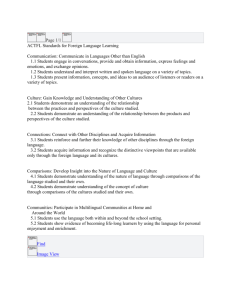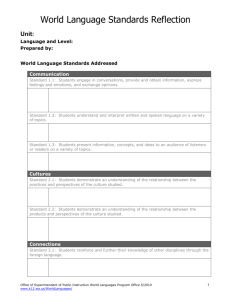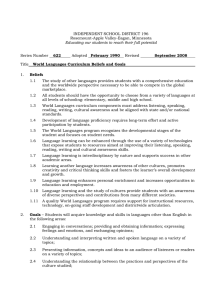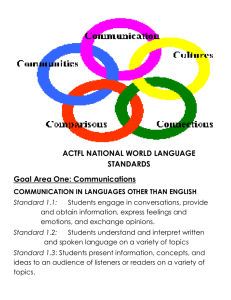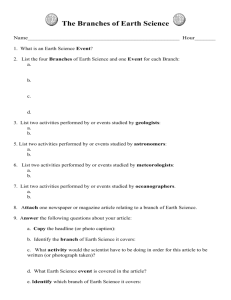Undergraduate Student Learning Outcomes University of Northern Iowa Department of Modern Languages
advertisement
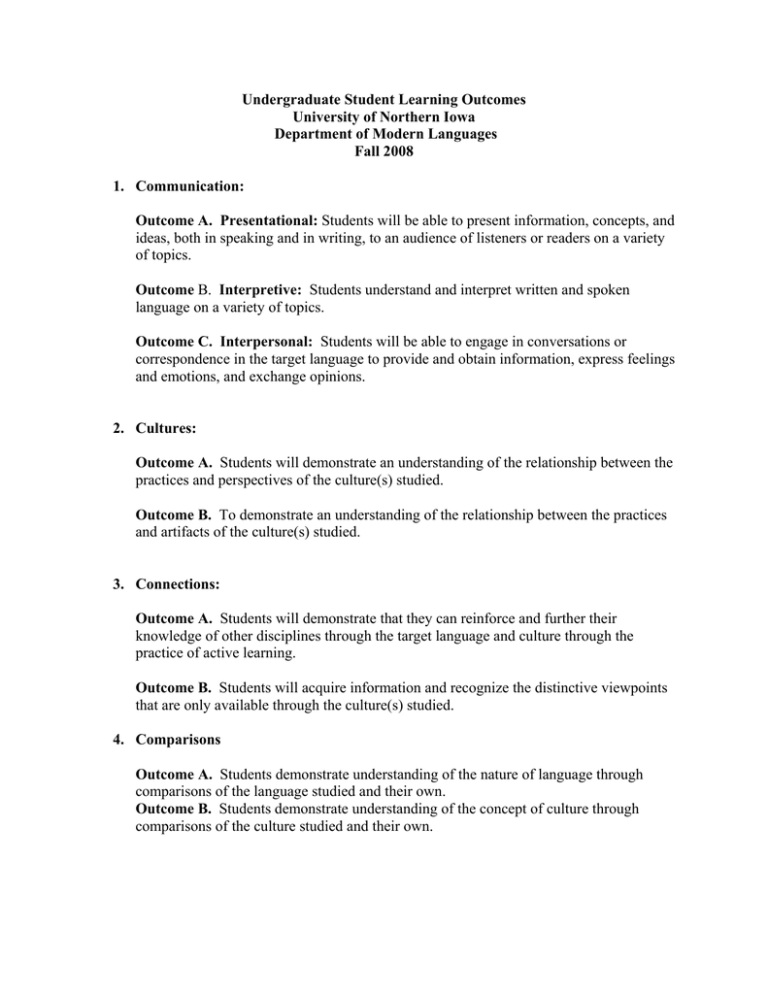
Undergraduate Student Learning Outcomes University of Northern Iowa Department of Modern Languages Fall 2008 1. Communication: Outcome A. Presentational: Students will be able to present information, concepts, and ideas, both in speaking and in writing, to an audience of listeners or readers on a variety of topics. Outcome B. Interpretive: Students understand and interpret written and spoken language on a variety of topics. Outcome C. Interpersonal: Students will be able to engage in conversations or correspondence in the target language to provide and obtain information, express feelings and emotions, and exchange opinions. 2. Cultures: Outcome A. Students will demonstrate an understanding of the relationship between the practices and perspectives of the culture(s) studied. Outcome B. To demonstrate an understanding of the relationship between the practices and artifacts of the culture(s) studied. 3. Connections: Outcome A. Students will demonstrate that they can reinforce and further their knowledge of other disciplines through the target language and culture through the practice of active learning. Outcome B. Students will acquire information and recognize the distinctive viewpoints that are only available through the culture(s) studied. 4. Comparisons Outcome A. Students demonstrate understanding of the nature of language through comparisons of the language studied and their own. Outcome B. Students demonstrate understanding of the concept of culture through comparisons of the culture studied and their own. 5. Communities Outcome A. Students use the target language both within and beyond educational settings. Outcome B. Students show evidence of becoming lifelong learners by using the language for personal enjoyment and enrichment. 6. Language Teacher Education: Outcome A. Graduating teaching majors demonstrate linguistic and cultural proficiency at the minimum levels indicated by Goals 1-5 above. Outcome B. Graduating teaching majors demonstrate knowledge of current foreign language teaching methods, including the knowledge, skills, and dispositions outlined in the INTASC + Technology standards. Outcome C. Graduating teaching majors demonstrate the ability to integrate technology effectively into foreign language classroom instruction. Curricular Alignment – German Please complete the following grid indicating the degree to which each of our program outcomes are currently addressed in each of the courses in your language curriculum. Use the following scale: 0 = not covered; 1 = introduced; 2 = some emphasis; 3 = strong emphasis. GOALS 1. Communication 2. Cultures 3. Connections 4. Comparisons 5. Communities 6. FL Teacher Education 740: 001/ 003 740: 002/ 004 740: 011/ 012 740: 013/ 014 740: 101 740: 102 740: 103 740: 104 740: 031 740: 105 1a. Presentational: to present information, concepts, and ideas, both in speaking and in writing, to an audience of listeners or readers on a variety of topics. 1b. Interpretive: To understand and interpret the target language on a variety of topics. 1c. Interpersonal: To engage in conversations or correspondence in the target language to provide and obtain information, express feelings and emotions, and exchange opinions. 2a. To demonstrate an understanding of the relationship between the practices and perspectives of the culture(s) studied. 2b. To demonstrate an understanding of the relationship between the practices and artifacts of the culture(s) studied. 3a. To demonstrate that they can reinforce and further their knowledge of other disciplines through the target language and culture through the practice of active learning. 3b. To acquire information and recognize the distinctive viewpoints that are only available through the culture(s) studied. 4a. To demonstrate an understanding of the nature of language through comparisons of the target language and their own. 1 1 2 2 3 3 3 3 3 3 3 3 3 3 3 3 3 3 3 3 3 3 3 3 3 2 3 2 2 3 1 1 2 2 1 1 3 3 3 2 1 1 1 1 1 1 2 3 3 2 1 1 2 2 2 1 1 1 0 2 2 2 2 2 3 2 3 3 3 3 0 0 0 0 0 0 0 2 0 0 4b. To demonstrate an understanding of the concept of culture through comparisons of the target culture(s) and their own. 5a. To use and draw from the target language and culture both within and beyond the classroom setting, including within a professional context. 5b. To show evidence of becoming lifelong learners by using the target language for personal enjoyment and enrichment. 6a. Graduating teaching majors demonstrate linguistic and cultural proficiency at a level of Advanced-low on the ACTFL Proficiency guidelines as indicated by Goals 1-5 above. 0 0 0 0 0 0 2 1 1 2 0 0 0 0 0 0 0 0 0 0 0 0 0 0 0 0 0 0 0 0 3 3 3 3 3 3 6b. Graduating teaching majors demonstrate knowledge of current foreign language teaching methods, including the knowledge, skills, and dispositions outlined in the INTASC + Technology standards. 6c. Graduating teaching majors demonstrate the ability to integrate technology effectively into foreign language classroom instruction. 0 0 0 0 0 0 0 0 0 0 0 0 0 0 0 0 0 0 0 0 STUDENTS WILL BE ABLE TO Curricular Alignment – Spanish Please complete the following grid indicating the degree to which each of our program outcomes are currently addressed in each of the courses in your language curriculum. Use the following scale: 0 = not covered; 1 = introduced; 2 = some emphasis; 3 = strong emphasis. Note: unless noted otherwise, all courses have the 780: prefix. 001 002 011 055/ 101/ 103/ 104/ 107 108 GOALS STUDENTS WILL BE ABLE TO 053 102/ 151 105 150 1. Communication 2. Cultures 3. Connections 4. Comparisons 5. Communities 1a. Presentational: to present information, concepts, and ideas, both in speaking and in writing, to an audience of listeners or readers on a variety of topics. 1b. Interpretive: To understand and interpret the target language on a variety of topics. 1c. Interpersonal: To engage in conversations or correspondence in the target language to provide and obtain information, express feelings and emotions, and exchange opinions. 2a. To demonstrate an understanding of the relationship between the practices and perspectives of the culture(s) studied. 2b. To demonstrate an understanding of the relationship between the practices and artifacts of the culture(s) studied. 3a. To demonstrate that they can reinforce and further their knowledge of other disciplines through the target language and culture through the practice of active learning. 3b. To acquire information and recognize the distinctive viewpoints that are only available through the culture(s) studied. 4a. To demonstrate an understanding of the nature of language through comparisons of the target language and their own. 3 3 3 3 3 3 2 1 2 2 3 3 3 3 3 3 3 3 1 2 2 3 3 3 3 1 2 1 2 2 2 2 3 3 2 2 1 1 2 3 2 3 3 2 2 1 1 2 2 2 3 3 2 3 1 1 2 2 2 3 3 2 2 1 1 2 2 3 3 2 3 3 4b. To demonstrate an understanding of the concept of culture through comparisons of the target culture(s) and their own. 5a. To use and draw from the target language and culture both within and beyond the classroom setting, including within a professional context. 5b. To show evidence of becoming lifelong learners by using the target language for personal enjoyment and enrichment. 1 1 2 3 2 3 3 3 2 0 0 0 1 2 3 2 2 3 0 0 1 2 2 3 3 2 3
